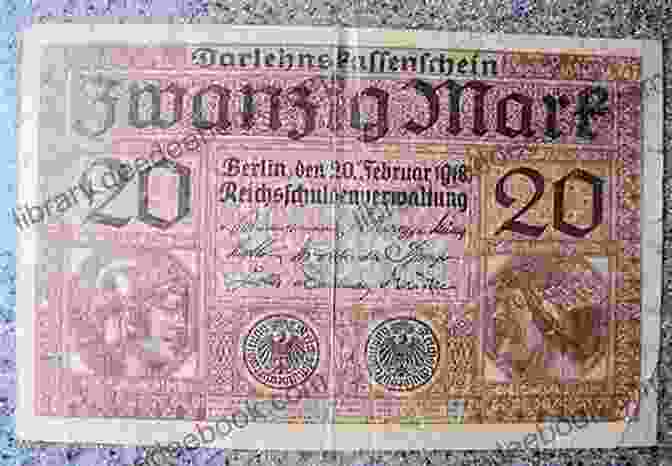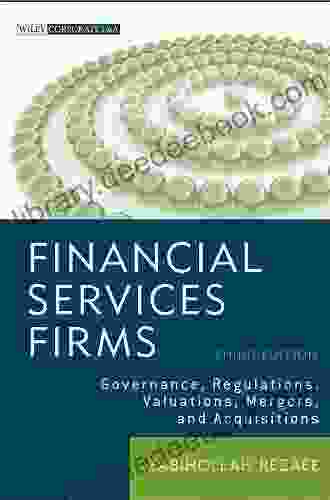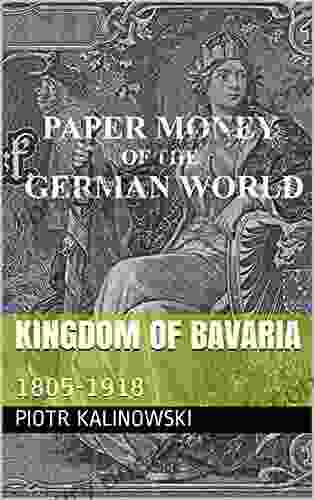1805-1918 Paper Money of the German World: A Comprehensive Guide


4 out of 5
| Language | : | English |
| File size | : | 12705 KB |
| Text-to-Speech | : | Enabled |
| Screen Reader | : | Supported |
| Enhanced typesetting | : | Enabled |
| Word Wise | : | Enabled |
| Print length | : | 43 pages |
| Item Weight | : | 3.53 ounces |
| Dimensions | : | 7.44 x 0.1 x 9.69 inches |
| Paperback | : | 46 pages |
The world of paper money in the German World between 1805 and 1918 is a captivating and multifaceted subject that has long fascinated collectors, historians, and economists alike. This period witnessed the rise and fall of numerous German states, the birth of the German Empire, and the tumultuous years of the Weimar Republic, all of which left a profound imprint on the nation's currency.
The paper money produced during this period reflects not only the changing political and economic landscape but also the artistic and technological advancements of the era. From the intricate designs and allegorical motifs of early banknotes to the sophisticated anti-counterfeiting measures employed in later issues, German paper money is a testament to the ingenuity and artistry of its creators.
Origins and Early Development
The origins of paper money in the German World can be traced back to the early 19th century, when the Napoleonic Wars ravaged Europe and disrupted the traditional gold and silver currency systems. In 1805, the Prussian state issued the first paper banknotes in an attempt to stabilize its economy and finance its war efforts.
These early banknotes were simple in design and often bore the signatures of the issuing authority. They were not universally accepted at first but gradually gained widespread circulation as the Prussian army marched across Germany. Other German states soon followed suit, issuing their own paper money to meet the demands of war and economic turmoil.
The German Confederation and Beyond
After the defeat of Napoleon in 1815, the German Confederation was established, which brought together 39 German states under a loose political union. The Confederation did not have a central bank, and each state retained the right to issue its own currency.
This period saw a proliferation of paper money designs, as each state sought to create distinctive and visually appealing banknotes. German artists and engravers played a significant role in crafting these designs, and the resulting banknotes showcased a wide range of allegorical figures, architectural landmarks, and historical scenes.
As the 19th century progressed, Germany underwent significant economic growth and industrialization. The demand for paper money increased, and new technologies were employed to improve the security and quality of banknotes.
The German Empire and the Reichsbank
The German Empire was proclaimed in 1871, uniting the German states under a single imperial government. The Reichsbank was established as the central bank of the empire, and it assumed responsibility for issuing paper money.
Reichsbank notes were renowned for their intricate designs and advanced anti-counterfeiting features. They featured allegorical figures representing virtues such as strength, wisdom, and industry, and they incorporated complex watermarks and other security measures to prevent counterfeiting.
The Reichsbank notes also played a crucial role in financing Germany's rapid industrial growth and military expansion. They were widely circulated throughout the empire and beyond, becoming a symbol of German economic and political power.
The Weimar Republic and Hyperinflation
After the defeat of Germany in World War I, the German Empire collapsed, and the Weimar Republic was established in 1918. The new republic faced severe economic challenges, including hyperinflation, which reached its peak in 1923.
During the hyperinflationary period, the Reichsbank printed vast amounts of paper money to finance government spending. As prices skyrocketed, the value of banknotes plummeted, and they became virtually worthless. The Weimar Republic issued increasingly large denominations of notes, including the infamous "billion-mark note," which was practically useless due to its astronomical face value.
The hyperinflationary crisis had a devastating impact on the German economy and society. It eroded savings, undermined trust in the financial system, and contributed to the political instability of the Weimar Republic.
Legacy and Significance
The paper money issued in the German World between 1805 and 1918 is a rich and diverse legacy that reflects the political, economic, and cultural history of the era. These banknotes provide valuable insights into the challenges and triumphs faced by the German people during a tumultuous period of their history.
Today, German paper money from this period is highly sought after by collectors and numismatists. Rare and well-preserved banknotes can fetch substantial prices at auctions, and they are prized for their historical significance and aesthetic appeal.
The 1805-1918 paper money of the German World is a fascinating and complex subject that continues to captivate collectors, historians, and economists alike. These banknotes offer a tangible connection to the past, allowing us to understand the economic, political, and social forces that shaped the German World during a period of profound change and transformation.
Bibliography
- Daniel Müller, 1805-1918 Paper Money of the German World, Battenberg Verlag, 2014
- Hans-Ludwig Grabowski, Paper Money of the German Empire 1871-1948, Krause Publications, 1987
- George S. Cuhaj, Standard Catalog of World Paper Money, Krause Publications, 2017
- Manfred Mehl, The Monetary History of Germany from the End of the Holy Roman Empire to the Present, Springer, 2012
4 out of 5
| Language | : | English |
| File size | : | 12705 KB |
| Text-to-Speech | : | Enabled |
| Screen Reader | : | Supported |
| Enhanced typesetting | : | Enabled |
| Word Wise | : | Enabled |
| Print length | : | 43 pages |
| Item Weight | : | 3.53 ounces |
| Dimensions | : | 7.44 x 0.1 x 9.69 inches |
| Paperback | : | 46 pages |
Do you want to contribute by writing guest posts on this blog?
Please contact us and send us a resume of previous articles that you have written.
 Book
Book Novel
Novel Story
Story Paperback
Paperback Magazine
Magazine Newspaper
Newspaper Paragraph
Paragraph Sentence
Sentence Shelf
Shelf Glossary
Glossary Bibliography
Bibliography Footnote
Footnote Scroll
Scroll Codex
Codex Tome
Tome Bestseller
Bestseller Narrative
Narrative Biography
Biography Autobiography
Autobiography Encyclopedia
Encyclopedia Thesaurus
Thesaurus Character
Character Resolution
Resolution Librarian
Librarian Catalog
Catalog Card Catalog
Card Catalog Borrowing
Borrowing Archives
Archives Periodicals
Periodicals Study
Study Research
Research Lending
Lending Journals
Journals Rare Books
Rare Books Study Group
Study Group Dissertation
Dissertation Awards
Awards Reading List
Reading List Theory
Theory Textbooks
Textbooks Chris Blazina
Chris Blazina Robert B Mccormick
Robert B Mccormick Jacques Bertin
Jacques Bertin Jennifer M Lane
Jennifer M Lane Leslie Hooton
Leslie Hooton Joshua Plenert
Joshua Plenert Christie Taylor
Christie Taylor Michael L Conniff
Michael L Conniff Thomas Hardy
Thomas Hardy Tim Pletcher
Tim Pletcher Eric Gurney
Eric Gurney Donald F Kuratko
Donald F Kuratko Phil Anger
Phil Anger Ralph Nader
Ralph Nader Jack Wiley
Jack Wiley Michael Myers Shoemaker
Michael Myers Shoemaker Sam Herting
Sam Herting Vincent B Chip Lococo
Vincent B Chip Lococo Elizabeth W Goldstein
Elizabeth W Goldstein Janet Neavles
Janet Neavles
Light bulbAdvertise smarter! Our strategic ad space ensures maximum exposure. Reserve your spot today!

 Fabian MitchellTales of the Time Dragon: An Epic Fantasy Adventure That Will Transport You...
Fabian MitchellTales of the Time Dragon: An Epic Fantasy Adventure That Will Transport You...
 Darnell MitchellPills of Sardinia: Discover Authenticity, Beauty, and Extraordinary Places
Darnell MitchellPills of Sardinia: Discover Authenticity, Beauty, and Extraordinary Places
 Leo TolstoyThe Complete Works of Julius Caesar: A Comprehensive Examination of the Roman...
Leo TolstoyThe Complete Works of Julius Caesar: A Comprehensive Examination of the Roman... Joe SimmonsFollow ·19.2k
Joe SimmonsFollow ·19.2k William FaulknerFollow ·16.7k
William FaulknerFollow ·16.7k Chadwick PowellFollow ·10.8k
Chadwick PowellFollow ·10.8k Ben HayesFollow ·18.6k
Ben HayesFollow ·18.6k Ryan FosterFollow ·9.6k
Ryan FosterFollow ·9.6k Julian PowellFollow ·15k
Julian PowellFollow ·15k Zadie SmithFollow ·13.6k
Zadie SmithFollow ·13.6k Christopher WoodsFollow ·4.9k
Christopher WoodsFollow ·4.9k

 Ralph Ellison
Ralph EllisonHealth Care Global Viewpoints: Samantha Whiskey
Samantha Whiskey is a global health...

 Gabriel Garcia Marquez
Gabriel Garcia MarquezTeacher Educators' Reflections on Culturally Relevant...
In today's...

 Levi Powell
Levi PowellSustainable Project Management: The GPM Reference Guide...
In today's rapidly changing world,...

 Isaac Bell
Isaac BellThe Captivating World of "Dreaming Awake Falling Under"
A Journey Through...

 Clarence Brooks
Clarence BrooksGovernance Regulations Valuations Mergers And...
In today's complex and ever-changing...
4 out of 5
| Language | : | English |
| File size | : | 12705 KB |
| Text-to-Speech | : | Enabled |
| Screen Reader | : | Supported |
| Enhanced typesetting | : | Enabled |
| Word Wise | : | Enabled |
| Print length | : | 43 pages |
| Item Weight | : | 3.53 ounces |
| Dimensions | : | 7.44 x 0.1 x 9.69 inches |
| Paperback | : | 46 pages |








